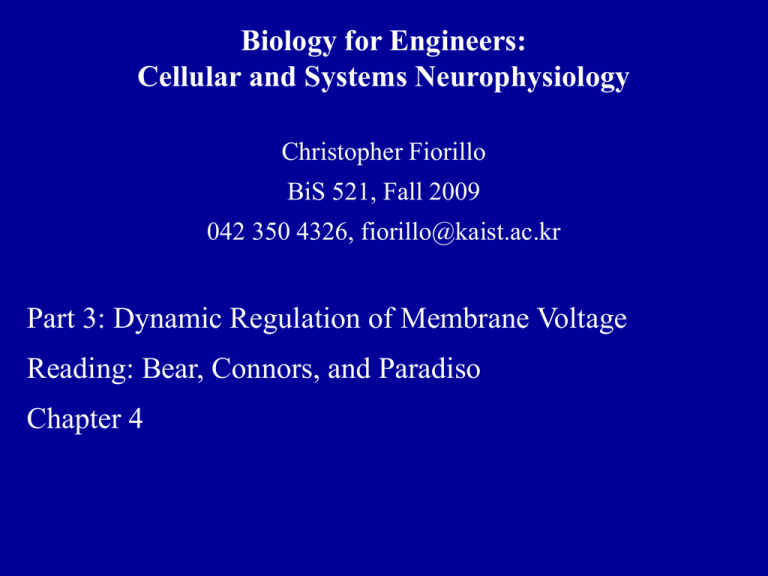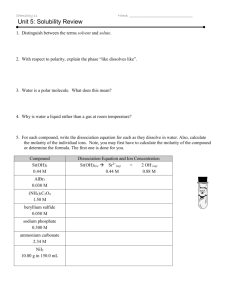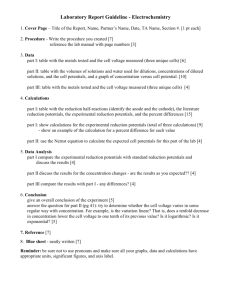Biology for Engineers: Cellular and Systems Neurophysiology
advertisement

Biology for Engineers: Cellular and Systems Neurophysiology Christopher Fiorillo BiS 521, Fall 2009 042 350 4326, fiorillo@kaist.ac.kr Part 3: Dynamic Regulation of Membrane Voltage Reading: Bear, Connors, and Paradiso Chapter 4 The Action Potential • Graded changes in current cause graded changes in voltage. • If voltage is depolarized beyond a threshold (about -50 mV), an action potential is triggered. An Action Potential is “All-or-None” • At a brief moment in time (~1 ms), an action potential either occurs or it does not • The shape of an action potential is always the same (almost) • The magnitude of the current and depolarization that triggered the action potential do not matter (but the depolarization must reach threshold) Firing Rate Depends on Current Magnitude • The frequency of action potentials (“firing rate”) depends on the magnitude of depolarizing current (assuming that the current lasts long enough). Why Do Neurons Have Action Potentials? • Current that enters the cell at one point will spread passively through the cytosol of a dendrite. • Because of membrane permeability, current leaks out of the neuron as it travels along a dendrite. • Thus information cannot be conveyed over long distances through passive spread of current. • An action potential is “regenerative” and therefore it can reliably carry information over long distances. • Trade-off: Digital (action potential) versus Analog (membrane voltage) • Most neurons have action potentials. • Many neurons that do not need to transmit information over long distances do not have action potentials. Phases of the Action Potential • • • • Rising phase Overshoot Falling phase Undershoot Properties of the Action Potential • Threshold – – • Rising phase – • K+ conductance greater than before start of action potential Absolute refractory period – • Inactivation of Na+ conductance Activation of K+ conductance Undershoot (After-Hyperpolarization) – • Positive membrane voltage (no functional significance) Falling phase – – • Increase in Na+ conductance Overshoot – • Caused by positive feedback among Na+ channels Requires high density of Na+ channels Na+ channel inactivation makes it impossible to elicit another action potential Relative refractory period – High K+ conductance means that a large depolarizing current is necessary to elicit another action potential The Hodgkin-Huxley Model • • • Hodgkin and Huxley described the ionic basis of the action potential (1952) This is considered the most important single achievement in cellular neurophysiology. Their approach: Experiments on the squid giant axon – – – • • • • • • • Two electrode voltage clamp (1 mm diameter axon) Measured the voltage-dependence and kinetics of sodium and potassium currents Ion substitution experiments They derived a relatively simple but detailed mathematical and biophysical model of the action potential Their model is still the “textbook” model The utility of their model extends beyond the action potential. It is useful for understanding all voltage-dependent ion channels Their model predicted some of the key properties of ion channels It was about 30 years later (~1980) that scientists were able to identify and record single ion channels It was about 10 years after that (~1990) that people began to clone ion channels (to discover their amino acid sequence) It was about 10 years after that (~2000) that the 3dimensional structure and function of ion channels began to be understood (Rod Mackinnon) The Patch Clamp Method • Developed by Erwin Neher • Very useful for electrophysiology • Enables the recording of single channels Recordings of Single Na+ Channels • Channels exist in discrete states: Open or closed • The channels “behavior” will not be the same, even under identical conditions. It is “stochastic.” • Inactivation occurs after the channel opens Relationship between single channel and cellular currents • Macroscopic currents in the cell result from the summation of many microscopic single channel currents • Although single channel currents are stochastic, currents within the cell are not. They are highly reproducible. • Single sodium channels do not have a threshold voltage at which they open • The action potential threshold depends on positive feedback between many sodium channels • Action potentials require a high density of sodium channels – A sufficient number of channels must be deinactivated (ready to be opened) Structure of Ion Channels • The Voltage-Gated Sodium Channel – Four subunits • • • • Each has 6 transmembrane alpha-helices Voltage sensor (positive charges) on S4 Selectivity filter K+ channel Gate Na+ channel The Voltage-gated Sodium Channel • Structure – gating and pore selectivity – Positive charges move with changes in voltage • Conformational change in protein • Gating current can be measured • Ion selectivity is possible because of the difference in size between sodium and potassium An Ion Channel Has Many States (Conformations) • States of a glutamate-gated ion channel (4 subunits) are shown • Open states require that glutamate is bound • There are many desensitized (inactivated) states • Gray states are seldom visited • This is typical of many ion channels, including voltagegated ion channels • This is probably more simplistic than reality Three Key Properties of Voltagegated Ion Channels • Ion selectivity • Voltage-dependence • Time-dependence (Kinetics) Voltage-Dependence of Ion Channels in HH model • ‘n-infinity’ is the steady-state probability that a K+ channel subunit “gate” is in the “open” conformation • The channel is only open when all four subunit gates are in open conformation – Thus, the steady-state probability that a channel is open: • Po = ninfinity4 • The Na+ channel has three activation gates (m) and one inactivation gate (h) – Thus, the steady-state probability that a channel is open: • Po = minfinity3h Summary of Voltage-Dependence of Parameters in HH model Diversity of K+ Channel Kinetics ventricular myocytes 200 ms Kv4.3 2000 ms Kinetics of Ion Channels Underlying the Action Potential • Sodium channels activate and inactivate quickly • Potassium channels activate slowly The Spread of Current Through Neurons • Passive spread of current DVx = DV0e-x/l l = square root (rm/ra) • Lambda is the “length constant” • At a distance lambda, the change in voltage will be 1/e of the original change in voltage • Actual length constants are 0.1 1.0 mm Action Potential Conduction • Propagation of the action potential – It is an active, regenerative process, but it still relies upon the passive spread of current – Orthodromic: Action potential travels from soma to terminal – Antidromic (experimental): Backward propagation (towards soma) Conduction Velocity • Conduction velocity (0.5-80 m/s) • Two means of increasing velocity – Diameter of axon (or dendrite) • Increases speed by decreasing axial resistance • Squid Giant Axon: 1 mm – Insulation • Myelination by glia • Increases membrane resistance and decreases membrane capacitance • Some information needs to be transmitted quickly, some does not • Large axons and myelination are each costly • Some axons are small and unmyelinated Myelination • Some axons are insulated by glial cells • Node of Ranvier – Gap in myelin sheath – High density of Na+ channels • Current decays as it passes from one node to another • Multiple sclerosis is caused by degeneration of myelin Initiation and propagation of action potentials • Requires a high density of sodium channels • High density is found in: – Axon – Nerve endings of primary somatosensory neurons – Dendrites have lower density, but some dendrites can have action potentials • Dendritic action potentials are not always all-or-none • Forward and backward propagation Beyond the Action Potential • We have focused on action potentials, but the HH model can be extended (by changing parameter values) to include many other types of voltage-gated ion channels • Voltage-gated ion channels do not only mediate the action potential. They also influence the pattern of action potentials. • Different neurons express different sets of voltageregulated ion channels – Therefore, different neurons have different firing patterns in response to the same excitatory input Measuring the Current-Voltage Relationship • The Current-Voltage relationship of a cloned Na+ channel – At very negative potentials, the channels are closed – At very positive potentials, the current is small, or positive, because of inactivation and the sodium reversal potential – It would be useful to measure the I-V curve when the sodium channels are open • A “tail current” protocol can be used for this purpose Measuring the Current-Voltage Relationship • A “Tail Current” protocol activates channels and then measures the I-V function at a brief moment in time – A voltage protocol is delivered that is designed to strongly activate the channels – The voltage is then stepped to different potentials, and the instantaneous “tail” current is measured at each potential – An I-V curve is constructed – Another I-V curve can be constructed without the first “activating” voltage protocol – The second I-V curve is then subtracted from the first. The resulting curve shows the I-V relationship of the isolated current. – In this example (from glial cells), the reversal potential of the current matches the theoretical K+ reversal potential • The I-V function is linear because it follows Ohm’s Law. – no time is allowed for the channels to open or close at the “new” voltage Voltage-regulated ion channels • Na+ channels – depolarization activated • Ca2+ channels – depolarization activated – L-type, T-type, N-type, P-type, Q-type, R-type • Cl- channels – depolarization activated – not common • Cation channel (non-selective; Na+ and K+) – Hyperpolarizaton activated – “H” current • K+ channels – – – – Depolarization activated Most diverse A-type, M-type, delayed rectifier, inward rectifier, etc. Multiple types of calcium-activated K+ channels (BK, SK, etc) K+ channel diversity • This shows only genetic diversity (~100 genes) • There is great diversity created by non-genetic mechanisms, such as alternative splicing of mRNA, post-translational modifications, varying subunit composition, and phosphorylation • There are probably hundreds, or even thousands, of functionally distinct K+ channels • A typical neuron might express about 10 types, or more Diversity of K+ Channel Kinetics ventricular myocytes 200 ms Kv4.3 2000 ms The AfterHyperpolarization in Hippocampal Pyramidal Neurons • Three components to the AHP, mediated by 4 K+ channel types – Fast • BK-type K+ channels, activated synergistically by calcium and voltage – Medium • M-type K+ channel, voltage-activated • Calcium-activated K+ channel – Slow • Calcium-activated K+ channel H-current (HCN channels) • HCN channels are hyperpolarization activated, nonselective cation channels that underlie the “H-current” Representation of Space and Time • Inputs to a neuron: – – Non-synaptic, voltage-regulated ion channels carry information from the past • The conductance of these channels depends on the history of a neuron’s voltage • Different types of channels represent different periods of the past, depending on their kinetics Synaptic inputs represent points in space • • Different synapses represent different points in space A neuron’s output depends on integration of the conductance of all of its ion channels




